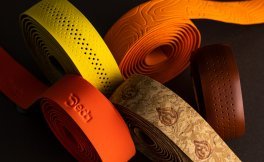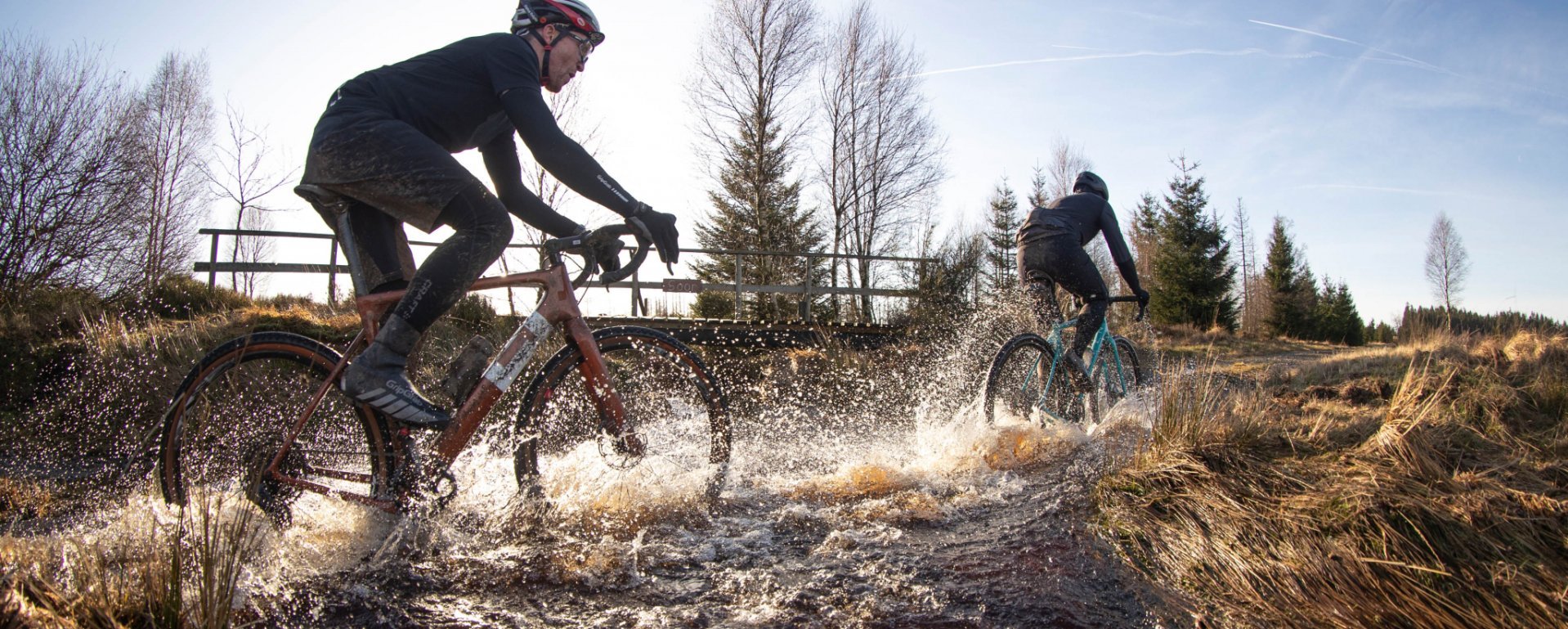
Product test: Thermoformable bike saddles from ...
A bike saddle that adapts to your anatomy? We have tested the thermoformable saddles from REFORM for you, which promise exactly that.
Drop – Reach – Flare: On road handlebars, aerodynamics and ergonomics must go hand-in-hand, so that you can bring your best performance to the road.
Almost 100 years ago, road cyclists had to accept the size and shape of their handlebars as virtually god-given, as handlebars were expensive and difficult to install. Things have changed since then, and you can now choose from many different models.
Basically, all racing handlebars consist of a straight middle section that curves downwards towards the outside. Due to their shape, they are also referred to as "drop bars". This type of handlebar has established itself among road bikes because it allows for an aerodynamically-favourable sitting position and, depending on the design, is used in many different areas of application. Drop bars are also popular on touring bikes because they offer numerous grip options, which relieves strain on the hands, arms and shoulders.
A road handlebar that is tailored to you and your riding style ensures that you can ride both long distances and short, intense sprints without pain and fatigue and with optimal power transmission. However, what should you look for when choosing handlebars? What do terms like drop, reach or flare mean?
Depending on the frame size, many road bikes are sold with a certain handlebar width as standard, which is rarely less than 400 millimetres. However, standards are poor indicators from an ergonomic point of view. The right width to suit your needs depends on your shoulder width. If you have rather narrow shoulders and always have to reach far out on your road bike, this will result quickly in shoulder, neck or arm pain and will affect your riding style and level of enjoyment. However, shoulder width only serves as a guide; the most important point of reference is your personal level of comfort. The intended use for your handlebars also plays a role: for aero, track or competition bikes, narrower handlebars are usually chosen because of their smaller frontal area. Marathon cyclists and other long-distance riders will be pleased with a little more width, as this offers more variety in terms of riding position as well as different grip options. Gravel bikers often choose the widest handlebars with flared bar ends for better off-road control.
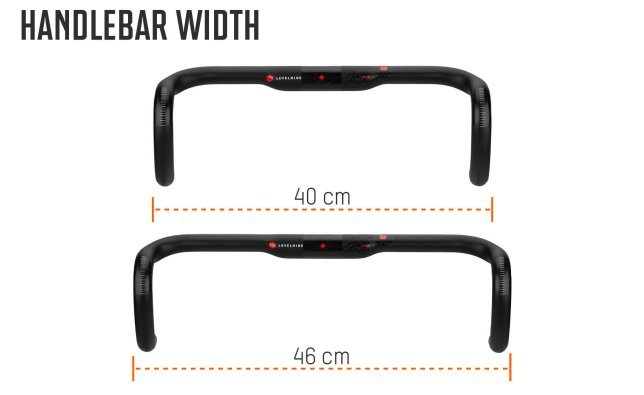
Drop and reach are other important factors when measuring and categorizing road bike handlebars. The drop refers to the handlebar height, i.e. the distance from the upper to the lower handlebar, in each case measured from the centre of the tube. If you’re someone who really likes to step on the gas, a set of handlebars such as the Fizik Cyrano R1 Snake with a lot of drop is a great option, as bending your upper body lower to the front decreases the amount of surface area that the wind can blow against. In this context, it is crucial that you should be able to ride a few kilometres without encountering issues while maintaining a physically demanding position. If you "only" manage a local shield sprint in the lower bar at the beginning, that's not bad at all. How deep you can reach has a lot to do with your physical condition, and can also be worked on through targeted strength exercises. Your arms should be slightly bent in posture, and your shoulders relaxed.
A low drop is better for those who often go on longer tours and value their comfort. Compact handlebars such as the LEVELNINE Race Compact Stealth usually have a drop between 120 and 130 millimetres. Because you don't have to bend down so low and can quickly reach around, this posture is easier on your back, allowing you to cover more distance in a relaxed manner. Gravel handlebars also often have a lower drop for more control off-road and better accessibility to the brake levers.
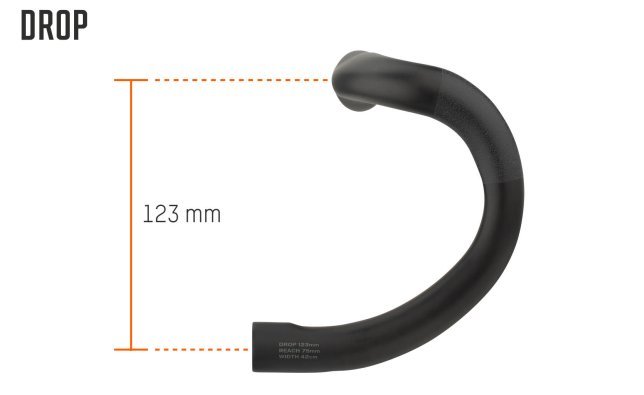
The reach also has an influence on riding style and comfort, because it determines how far you have to stretch when you’re sitting on your bike. With a big reach, you reach further forward from the top bar to reach the brake handles, also called horns or hoods. It is measured from the centre of the stem clamp to the point in the drop farthest from it (the fixed point is also the centre of the tube). Compact handlebars that focus on comfort such as the SL-70 Ergo by Zipp are therefore not only characterised by a low drop, but also by a short reach.
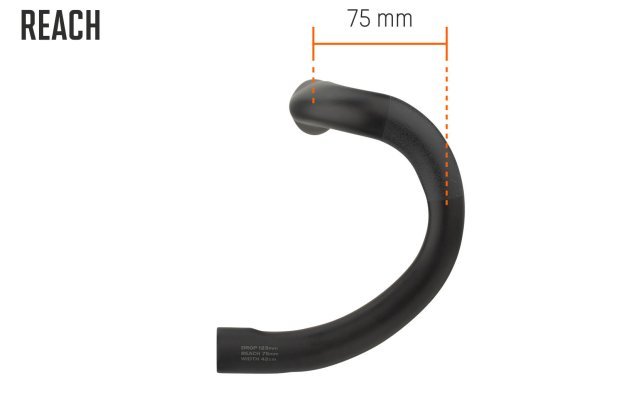
Only a few types of road bike handlebars have a backsweep, i.e. a slight angling of the handlebar halves to the rear, which is specified in degrees. The backsweep supports the natural position for hands and wrists. For example, the Ritchey WCS Carbon Streem II has a wing-like upper bar that enables a comfortable hand position, which is especially noticeable when riding uphill or across long distances. Be careful, however: the bigger the backsweep, the more upright the riding position and the closer the drops to the body. The rise also provides a slightly more upright riding position, more opportunities to grip the handlebars and thus more comfort. It refers to a slight horizontal slope of the handlebar on either side of the clamp, and is denoted in millimetres. However, since this comes at the expense of aerodynamics, a rise is rarely found in competition-style road bike handlebars. The situation is different for comfort and long-distance applications. For example, riser drop bars are available from Specialized as part of the Hover series.
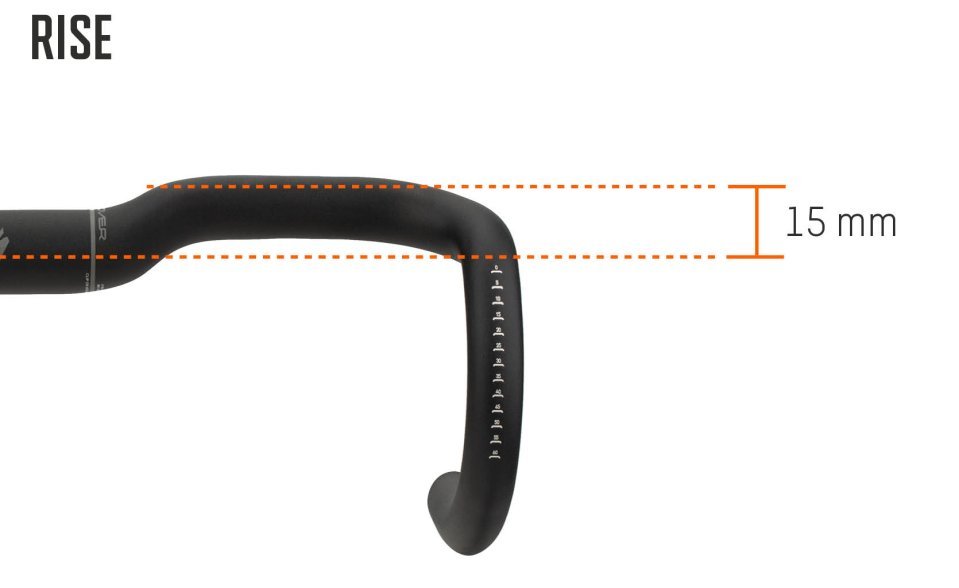
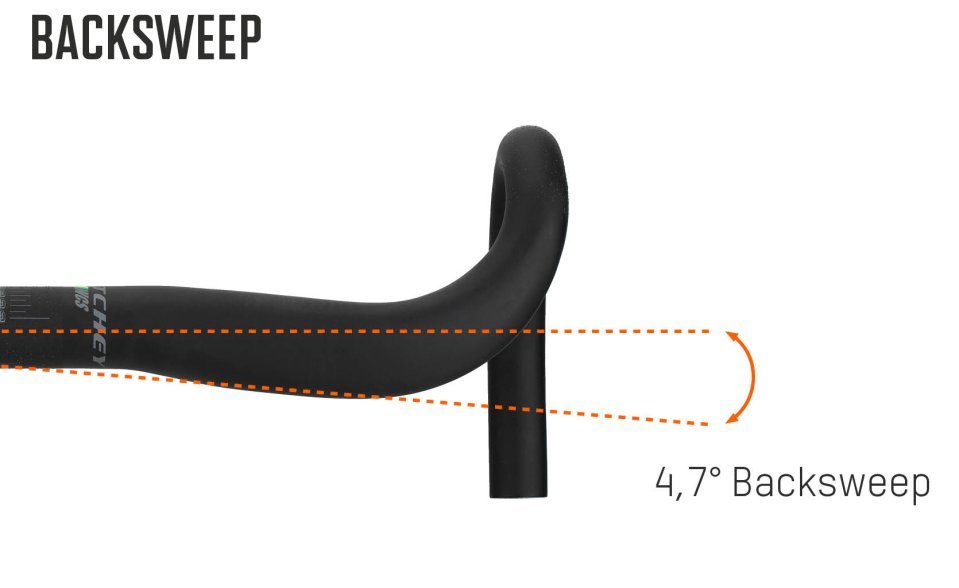
It is not only the handlebar reach and backsweep that determine the riding position, but above all the stem and frame length. For example, handlebars with a short reach and some backsweep can make a factory stretched riding position more comfortable. Conversely, the combination of a short stem, short main frame and lots of backsweep can cause your knees to collide with the lower bar in tight corners. You should therefore never just look at the values of the handlebars alone. Always factor in the sitting position on the road bike when considering parameters overall.
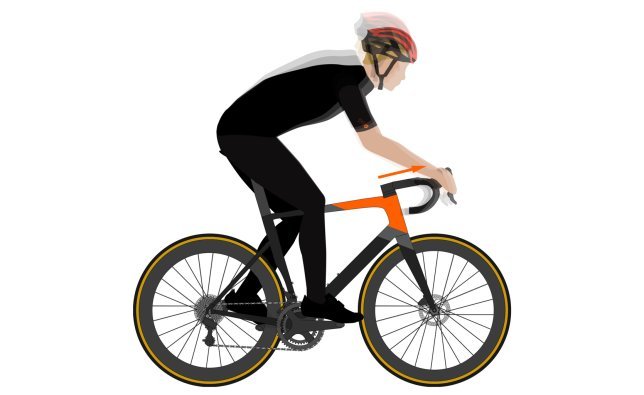
You can significantly change your riding position by adjusting the length and pitch of your stem. © bc GmbH & Co. KG
When the lower bar is flared and therefore wider than the upper bar, it is called flare. A large flare gives you better handling and more control, which is especially useful off-road. This is why you'll find road handlebars with flare values of ten degrees or more, especially on gravel bikes. We will dedicate more to the topic of flare and gravel handlebars in a separate text.
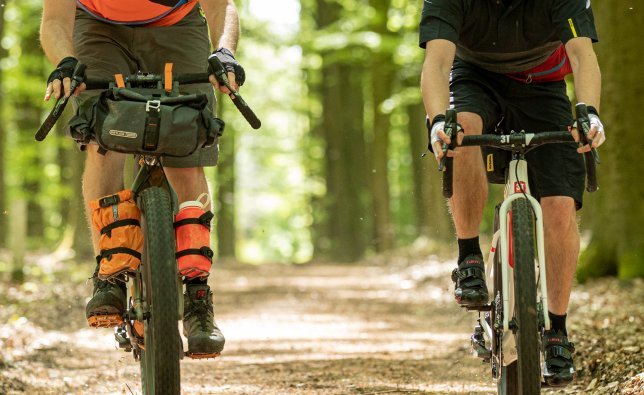
Gravel handlebars (left) vs. road handlebars: the flare makes the difference and offers more control off-road. © bc GmbH & Co. KG
In addition to the special case of "gravel handlebars," one basically distinguishes between competition-style road handlebars, compact handlebars and ergonomic road bike handlebars. The one suits you best depends on your personal preferences, your riding style and your body’s measurements.
Each model differs in the shape of the drop – there are the classics with a large reach and drop, the compact models with a low reach and drop (which even professionals now often ride), and last but not least the ergonomically-shaped models. These have a slightly longer and sometimes thicker tube along the lower bar, which allows different grip positions and relieves pressure on the hands.
Various shapes, which can often appear a bit over-the-top, can be found especially in the field of aero handlebars. On models like the Specialized S-Works Aerofly II, the top bar is extremely flattened, which reduces drag while providing a wider grip area for comfort. Aerodynamically-shaped handlebars are not only interesting for sporty drivers, but also for rouleurs. On long journeys, they save weight with lightweight models and benefit from an ergonomic design. Since aero handlebars are made from carbon and scratch more easily than aluminium models and have relatively wide, flat top tubes, it's difficult to mount lighting or navigation devices on them. However, many manufacturers now offer special mounts so that you can also keep an eye on your power output in the aero cockpit or on the handlebar mounts.
Triathletes who argue over every gram and every ounce of power also use aero handlebars. If you own a “normal” bike not especially meant for triathlons, but want to see through swimming, cycling and running stages to the end, handlebar attachments are a good option, and can be mounted on the handlebars with clamps. Simpler models like the BBB Aerobase BHB 52 are available starting under 50 Euros. Attachments help you to adopt a streamlined and simultaneously relaxed sitting position, which you can vary with adjustable armrests.
If your primary opponent is the clock, i.e. in triathlon or time trial competitions, then special time trial handlebars or triathlon handlebars are a good option. With them you can maintain an even flatter, aerodynamic sitting position, and on the attachments your forearms can relax a bit after swimming in a triathlon. The shifters are also at the front of the attachment ends, which means don't have to reach back. Time trial handlebars have a horn-like shape and consist of a straight to slightly-curved top tube that flows into grips on each side, with extensions resting in the middle. On models like the Vuka Aero Carbon from Zipp, the height, width and length of the arm shells can be adjusted to fit each athlete precisely.
As far as choosing a frame is concerned, it’s a fundamental question for many. As is often the case, however, both materials have their advantages and disadvantages. The significant advantage of carbon over aluminium is its low weight combined with high stiffness values. Carbon fibres, which are imbued with a high degree of vibration damping, provide more comfort and allow for specifically flexible constructions. Carbon also has the advantage of a much freer design, which can be seen in designs such as flatter tops on aero handlebars. However, compared to aluminium, carbon road bike handlebars are more expensive and are also more delicate. However, since most of the handlebar surface is wrapped with tape, this aspect, unlike the frame, plays a rather minor role. Even so, you should still pay attention to the correct tightening torques for carbon handlebars and use a torque wrench and carbon assembly paste for assembly. Aluminium has its own advantages as well, and not just in terms of price. In this regard, manufacturer LEVELNINE offers very good and inexpensive road models. Furthermore, aluminium is robust and can also be forgiving when it comes to improperly tightened screws. Even if aluminium handlebars weigh a little more overall than their carbon counterparts, the difference is only perceptible by a few hundred grams at most. Incidentally, be on the lookout for those who use aluminium handlebars in their "Pain Cave" during training. That said, sweat is a known cause of unpleasant corrosion disasters that can build up under handlebar tape. Carbon has a clear advantage here.
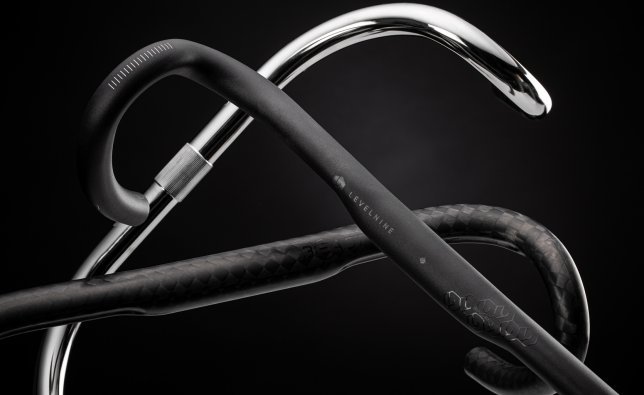
Steel was and is popular, and remains a true classic. With its impressive high stiffness values, relatively low price and robustness, its enduring appeal is little wonder. The only downside: steel is a heavy material, which is why manufacturers in the racing sector, where competitors fret over every gram, primarily rely on aluminium and especially carbon. But enthusiasts will certainly always find a "steel hanger". For example, manufacturer Nitto offers track bike handlebars made of steel in various widths and with a drop of 152 and 170 millimetres.
When the pros thunder over cobblestones ("pavée") at Paris-Roubaix in spring, they don't just make use of flexing carbon handlebars, carbon seatposts and relatively low tyre pressure, but also of thickly-wrapped handlebar tape to absorb shock to their arms. Even if your tours take you over less demanding terrain, handlebar tape with shock-absorbing properties makes sense because it increases comfort and prevents fatigue. Manufacturer Fizik relies on a polymer layer to dampen vibrations in the Tempo Microtex Bondcush Soft. Additionally, the material absorbs moisture and the roughened surface prevents your hands from slipping. Typically, handlebar tape is around 30 millimetres wide and is made of either a vinyl-cork blend, leather or polymer composites. What all types have in common is that they are insensitive to sweat and moisture and offer optimal grip, whether you are on the move with or without gloves. Last but not least – handlebar tape lets you put your road bike in the spotlight. We have the right handlebar tape in all of your favourite colours – from celeste blue to camel beige to pink, white or black. Our colour filter will help you to quickly find the right colour for your new handlebar tape.
